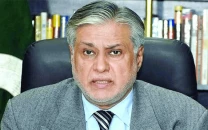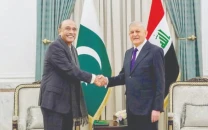Rupee-dollar parity projected to remain volatile
IMF assumption suggests average exchange rate to hover around Rs305 by June 2024

The International Monetary Fund’s latest assumptions suggest that the average exchange rate could be around Rs305 to a dollar at the end of the current fiscal year, which is higher than the rate quoted by the government to prepare the budget for the ongoing year.
Neither has the IMF given the exchange rate in its recent staff-level report explicitly nor is there any agreed rate between Pakistan and the foreign lender.
The underlying assumptions are used to work out current account deficit, suggesting that the IMF has priced the dollar at an average rate of over Rs305.
The fresh IMF assumption is lower as compared to the State Bank of Pakistan’s internal workings that projected the average rate at Rs308 to a dollar, according to the sources. The government had prepared the budget for financial year 2023-24, basing the exchange rate at Rs290 to a dollar.
If the dollar crosses the Rs300 mark during the course of the current fiscal year, it will have an impact on the defence budget, foreign debt servicing, the cost of running Pakistan’s missions abroad and the Public Sector Development Programme (PSDP).
Any fluctuations in the dollar rate or underestimation at the time of budgeting can render the entire budget unrealistic, leading to cost overruns and the need for supplementary grants.
In the staff-level report, the IMF has not stated the exchange rate valuation in explicit terms again. The numbers have been worked out on the basis of backward working of the current account deficit projections that show that the rupee would keep losing its value under the IMF programme and beyond it.
The assumptions are subject to changes. The improvement in the external inflows, higher exports and remittances can result in less depreciation of the rupee. One of the factors undermining the exports is a constant rise in the cost of doing business due to higher taxes, transport cost and rise in electricity and gas tariffs.
In the past, the IMF had said that “published staff reports on Pakistan include exchange rate assumptions which are not predictions. Under the IMF-supported programme, there is not an agreed target level for the exchange rate, which is market-determined”.
The average exchange rate of Rs305 to a dollar by June 2024 means that the year-end rupee-dollar parity will be higher than this threshold.
The IMF’s report showed that the size of Pakistan’s economy -- in rupee terms -- will be Rs108.9 trillion by June this year, and it is projected at $356 billion in dollar terms.
For the past few days, the rupee has been constantly losing its value against the US dollar after initially gaining by 3.8% on the back of the Pakistan-IMF staff-level agreement for the $3 billion package.
The dollar price closed at Rs283.80 on Wednesday. Pakistan’s economic fundamentals remain weak and there is still high demand for the dollars in the market.
The IMF was very critical about Pakistan’s management of the exchange rate during the past one year.
The IMF staff-level report stated misaligned economic policies -- including large fiscal deficits, loose monetary policy, and defending an overvalued exchange rate -- had fueled consumption and short-term growth, steadily eroded
macroeconomic buffers, increased external and public debt, and depleted international reserves.
After reserves fell to about $3 billion in mid-January 2023, the exchange rate was allowed to depreciate by almost 10% on January 26, stated the IMF. However, the normalisation in the FX market was short-lived, with premium reemerging in February and again from May onwards on the back of import restrictions, stated the IMF.
The IMF emphasised that the SBP would need to continue its tightening cycle to re-anchor expectations given that inflationary pressures are expected to persist over the coming year, including because the impact of exchange rate corrections will continue to reverberate through the economy.
The IMF has now placed a condition that binds Pakistan to restrict the difference between the interbank–open market premium within 1.25% range on average.
Finance Minister Ishaq Dar and the State Bank of Pakistan governor have also given fresh assurances to the IMF aimed at avoiding further exchange rate management.
“We, therefore, reaffirm our commitment to return to a market determined exchange rate and, in line with the Foreign Exchange Regulation Act, banks and exchange companies are at liberty to determine exchange rates between Pakistani rupees and foreign currencies free from any formal or informal influence”, according to the Memorandum of Economic and Financial Policies (MEFP).
Both the co-signatories of the Letter of Intent further committed that they “will refrain from providing guidance or expressing preference to market participants regarding the exchange rate or regulate demand for FX through (either formal or informal) administrative action”.
Pakistan has also committed that in order to enhance transparency and efficiency in the foreign exchange market, it will publish daily the interbank and open market exchange rates, and develop a framework to monitor and publish developments and pricing in the informal market.
It will also accelerate work for transitioning to a new trading platform for spot transactions connecting all banks and make it operational by end-December 2023.



















COMMENTS
Comments are moderated and generally will be posted if they are on-topic and not abusive.
For more information, please see our Comments FAQ